
These pages are a collection of odd pictures
and trivia about llamas.
(They are not for sale, they are simply for your entertainment.)
Anaglyph 3D Pictures of Llamas

We have converted the 3-D stereoviews on the Trivia Page 26 to anaglyph format
so that they can be seen by using a set of red/blue anaglyph glasses.
If you don’t have any of these glasses lying around,
you can get a set of free anaylph glasses
by sending a stamped self-addressed envelope to this 3-D supply company.
There are also anaglyph glasses in some issues of magazines
that you might have lying around such as
the August 1998 National Geographic or the winter issue of Sports Illustrated.
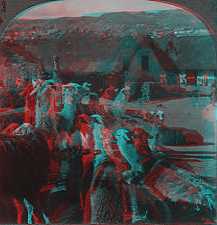
The write-up on the back of the card above says:
|
LLAMAS, CERRO DE PASCO, PERU
Cerro de Paso is built over a silver mine and there are hundreds of silver and copper mines in the mountains around it. It is sit- uated about 14,000 feet above the sea in the bleakest part of the Andes, back of Lima, near the central western part of Peru. The town lies in a basin surrounded by barren rocks. Cero de Pasco is thought to be the crater of an extinct volcano. Though the town is is surrounded by great mineral wealth, it is, like most mining towns, very unattractive. Almost all of the freight in this district is carried on llamas, these little pack animals of the Andes. The llama is one of the aristo- crats among quadrupeds. Notice his appear- ance: he has a camel’s hair, a sheep’s body and the feet and legs of a deer. From the sole of his hoof to the top of his head he measures about three feet. The llama carries |
his burden with a proud air and when he sees anything new he pricks up his ears like a skye- terrier. He will carry only so much, his usual load being one hundred pounds. If the In- dians put on more he does not cry or groan as the camel does, but calmly kneels down and waits until the load is lightened. Llamas are gentle when well treated. They seem fond of their Indian masters. The men are also fond of the llamas; they pet and talk to them as if they were human beings. When on a journey they always walk beside the beasts, stopping to let the animals graze from time to time. The Indian women spin the fleece of the llama into wool and weave it into cloth. it is rather coarse but serves to make the ponchos or blanket cloaks and rough dress worn by the average native. Copyright by The Keystone View Company |
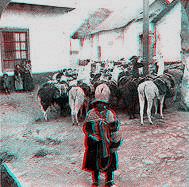
This stereo picture is titled
“Pack Train of Llamas, Unique Andean Beasts of Burden,
with Indian Driver, Cerro de Pasco, Peru”.
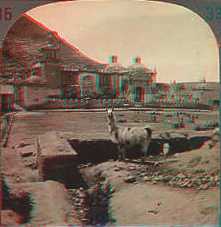
This stereo picture is titled
“Famous Copacabana Church near Lake Titicaca in Bolivia — Llama in Foreground, So. Am.”
However, on the back of the card it says that the church is in Peru.
(My atlas shows Copacabana just over the border in Bolivia.)
Also on the back is a little blurb about the llama:
In the foreground you see a llama.
It belongs to the camel family. Its color
is usually white, but it sometimes has a brown
or black spots on it, and occasionally a brown
or black one is seen. It is the principal pack
animal in the mountains of Peru and Bolivia.
It is a sure of foot as a goat, yet large enough
to carry a load of 100 lbs. If it is too heavily
loaded it will kneel down and refuse to move
until part of the burden is removed. Great trains
of them carry ore from the mines to the coast,
and bring back loads of manufactured goods.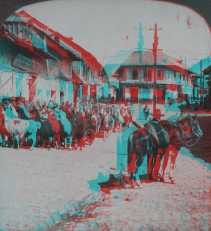
This stereoview from 1907 is titled “Llamas, famous Andean beasts of burden, at Cerro de Pasco, Peru”.
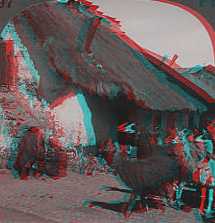
A 1906 stereoview by Keystone View Company titled
“Llamas, the Pack Animals of the Highland Dwellers of South America”.
The write-up on the back of the card says:
| LLAMAS, THE PACK ANIMALS OF SOUTH AMERICA Before Christopher Columbus discov- ered America the Indians had no horses. They used dogs as beasts of burden. In South America, the Indians of the Andes Mountains used llamas. So there were only two animals in all the New World to help man with his burdens. The llama is still carrying the burdens of man. The llama is a cousin of the camel. It has a head like a camel. The body of the llama is like that of a sheep. Its feet and legs are like those of a deer. It is the father llama that carries the bur- dens. It can carry only about a hundred pounds. If its master puts on more than the llama can carry, it will calmly kneel |
down. Then it will wait until the load is made lighter. The llama will not cry out or groan as does the camel. the llama can travel only about twelve miles in a day. From the mother llama the Indians get milk. The Indian women use the wool fleece of the llama. They weave this into cloth. It is not fine cloth. The blankets these men are wearing are made of llama wool. Llamas are gentle beasts if they are well treated. They seem to be fond of their Indian masters. The Indians are fond of the llamas, too. They make pets of the llamas. They will talk to their llama pets like you talk to your pets. When on a journey the Indian master will walk beside his llamas. Copyright by The Keystone View Company |
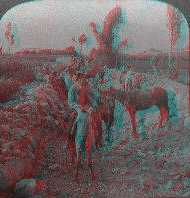
A 1906 stereoview titled “Packtrain of donkeys and llamas, Arequipa, Peru.”
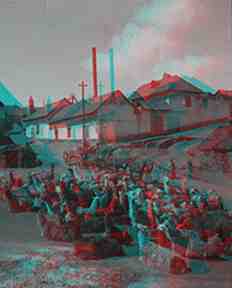
A stereoview titled “Llamas, mountain cousins of the camel,
resting between weary journeys. Cerro de Pasco, Peru.”
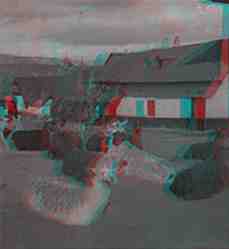
A stereoview titled “Llamas resting between mountain journeys at Cerro de Pasco, Peru.”
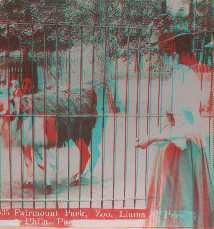
A llama in the Fairmont Park Zoo in Philadelphia by Webster & Albee of Rochester, New York.
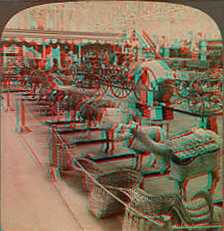
A stereoview by Underwood & Underwood, 1904, titled:
Primitive Methods of Carrying Freight and Passengers —
Transportation Building — World’s Fair, St. Louis, USA.
The exhibit includes a stuffed llama, a sheep, and a goat,
along with horses and donkeys with their baskets.
Part of the text on the back of the card follows:
There are nearly sixteen acres of ground space under this one roof,
occupied by exhibits showing the devices men have thought out for moving
themselves and the things they need, from one part of the earth to another.
Naturally, most of the exhibits show the very latest ideas,
but it gives some space also to comparison of the new
with such primitive ideas as you see here. The stuffed beast
with the long neck is the South American llama laden with wicker panniers,
— in many regions he still represents our own fast freight trains!
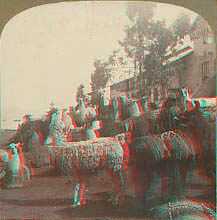
Paul Rose of Roseland Llamas in the UK has a nice selection of “lamarabilia”
and has kindly given us permission to use this stereoview
which is from their collection.
It is titled “Llamas, the pack camels of the Andes, awaiting
cargoes outside a brewery, La Paz, Bolivia.”
We have some colour stereo pictures of some of our llamas as well as
some 3-D pictures taken around the farm plus some stereo llama hiking pictures.
More Llama Trivia Pages:
Visit some of our other web pages:
